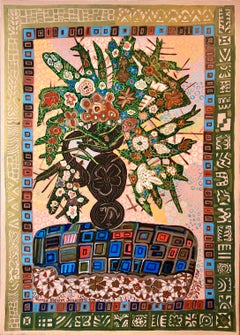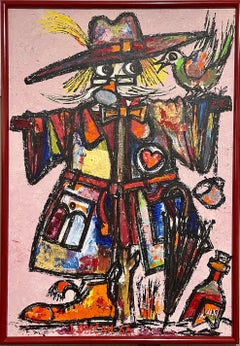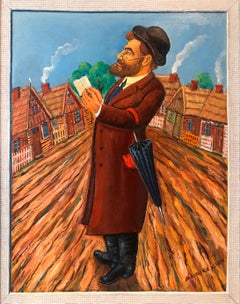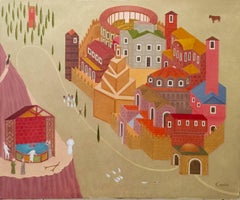Want more images or videos?
Request additional images or videos from the seller
1 of 17
Michael GleizerBochurim Dancing 770 Chabad Synagogue Judaica Jewish Chassidic Art Oil Paintingc.2000-2010
c.2000-2010
$6,500List Price
About the Item
- Creator:Michael Gleizer (1946, Russian)
- Creation Year:c.2000-2010
- Dimensions:Height: 47 in (119.38 cm)Width: 66 in (167.64 cm)
- Medium:
- Movement & Style:
- Period:
- Condition:good. minor scuffing. minor scratches,minor wear to edges of plywood will be covered by frame. Please see photos.
- Gallery Location:Surfside, FL
- Reference Number:1stDibs: LU3824943141
About the Seller
4.9
Platinum Seller
Premium sellers with a 4.7+ rating and 24-hour response times
Established in 1995
1stDibs seller since 2014
1,807 sales on 1stDibs
Typical response time: 1 hour
Authenticity Guarantee
In the unlikely event there’s an issue with an item’s authenticity, contact us within 1 year for a full refund. DetailsMoney-Back Guarantee
If your item is not as described, is damaged in transit, or does not arrive, contact us within 7 days for a full refund. Details24-Hour Cancellation
You have a 24-hour grace period in which to reconsider your purchase, with no questions asked.Vetted Professional Sellers
Our world-class sellers must adhere to strict standards for service and quality, maintaining the integrity of our listings.Price-Match Guarantee
If you find that a seller listed the same item for a lower price elsewhere, we’ll match it.Trusted Global Delivery
Our best-in-class carrier network provides specialized shipping options worldwide, including custom delivery.You May Also Like
The Eyes of the Lord Moves Round (Howard Finister in Ghana ? )
Located in Miami, FL
"The Eyes of the Lord Moves Round in All Places Beholding the Good and the Evil" Is Kwame Akoto ( All-Mighty God) the Ghanian Howard Finister? His works...
Category
Early 2000s Folk Art Figurative Paintings
Materials
Plywood, Mixed Media, Oil
Bold San Francisco Abstracted Still Life Composition in Oil on Board
By Frank Koci
Located in Soquel, CA
Bold San Francisco Abstracted Still Life Composition in Oil on Board
Bold still life composition by Frank Koci (Czech-American, 1904-1983). A table is set with a jug of wine and a bowl of fruit and a landscape in the background. It is composed of several layers of paint, with bold outlines. In some areas, paint has been scraped away to create additional texture. In broad terms, you can describe Koci’s paintings as a series of “people-scapes,” wherein people are shown having relationships (some fleeting, some enduring) with fellow humans. A better term is probably “preludes” — wherein each painting sets the stage for something momentous that will occur in the very next frame. In the best Kocis, the tension is palpable.
Signed in the lower right corner "Koci".
Presented in a wood frame.
Board size: 13"H x 30"W x .5"D
Born in 1904 in Pilsen Czechoslovakia to a widowed mother. Koci grew up in poverty. Leaving Pilsen at 17 he was already too sophisticated about arts and literature, drama, and polished...
Category
1960s Outsider Art Figurative Paintings
Materials
Plywood, Oil
$920 Sale Price
20% Off
H 13 in W 30 in D 0.5 in
"Cars, Buildings People" Contemporary Outsider Folk Art African American Urban
By Purvis Young
Located in New York, NY
"Cars, Buildings People" Contemporary Outsider Folk Art African American Urban
The painting measures 65 x 48 inches. We love that in the middle of ...
Category
1990s Outsider Art Landscape Paintings
Materials
Masonite, Oil
Purvis Young"Cars, Buildings People" Contemporary Outsider Folk Art African American Urban, c. 1990s
$55,000
H 68 in W 51 in D 2 in
American Outsider Folk Art Painting "The Wall-Flower" by Gussie Smith Roth 1965
Located in San Francisco, CA
American Outsider Folk Art Painting "The Wall-Flower" by Gussie Smith Roth C.1965
Original oil on masonite
Masonite dimensions 28" wide x...
Category
Mid-20th Century Folk Art Figurative Paintings
Materials
Masonite, Oil
$550
H 24.5 in W 30.25 in D 1 in
A Haitian Country Scene
Located in San Francisco, CA
Haitian artist Jacksin Mésidor painted this from his Caribbean coastal hometown of Cap-Haitien in the north of his native land. As Haitian folk art, the painting delivers an archityp...
Category
20th Century Folk Art Figurative Paintings
Materials
Masonite, Oil
Stickball Team sports related group male figures earth and red colors
By Stephen Basso
Located in Brooklyn, NY
The painting hardens back to the artist's memory of stickball played on YYC streets. The rough texture is created by pumice like material mixed with the primer. It is on wood signed ...
Category
2010s Outsider Art Figurative Paintings
Materials
Wood, Oil
$2,400
H 24 in W 20 in D 1 in
Bluebird Spring garden setting large female figure soft warm Grey violet yellow
By Stephen Basso
Located in Brooklyn, NY
This is an oil painting on jute canvas mounted on a cradled wood board. It is signed and dated by the artist on reverse. The texture is rough yet dense with a strong balance of light...
Category
2010s Outsider Art Figurative Paintings
Materials
Jute, Wood, Oil, Canvas
$3,800
H 36 in W 36 in D 2 in
What Are They Looking At ? Sexy Nude Naive Caribbean Art , Swimming Pool Party
By Wilson Bigaud
Located in Miami, FL
A young man at a crowded upper-class Haitian swimming pool attracts attention. We see him only from the back in a Magritte-like pose. The transfixed expressions of some of the nubile bare-breasted bathing beauties and one man with his hands down his pants give us a clue that the mystery man is special.
This is a fascinating work packed with drama and overflowing with pent-up emotion.
Bigaud's narrative is as complex as his figural composition of lookers and swimmers. Notice the sight lines of the lookers go back to front while the two swimmers go from left to right. The twenty-two figures are contained in the rectangular shape of the pool, which is pushed to the front of the picture plane. The cars of the pool partygoers are seen in the background with one witness. He is fully clothed and is most likely a chauffeur. The fully clothed female at the pool offering food is a servant. A boxy-looking radio with a pack of cigarettes and the style of the cars give glue to the date. Most Haitian art depicts average working people. The pool party departs from that tradition and shows life of the Haitian upper class. Most likely, this was painted in Petion-Ville. The higher the elevation in Port-au-Prince the more wealthy the homes. Although the artist's painting technique may be described as naive or lacking polish.
t's one of the reasons why the work radiates charm and interest.
The painting is oversized with huge dimensions of 55 x 48 and will be a statement in any room. Wilson Bigaud is considered to be a Haitian master. The condition is good. Three repaired one-inch issues on the extreme center and upper right edge. Visible only on close inspection. Otherwise presents very well and is elegantly framed,
______________________________________
Haitian master Wilson Bigaud is renowned for works portraying everyday life and rites of passage—vodou rituals, fortune-tellers, weddings, cockfights, and carnivals—with voluminous figures and lucid colors. Born in Port-au-Prince, in 1946 Bigaud was among the first to attend DeWitt Peters’s Le Centre d’Art d’Haïti, where he studied with Hector Hyppolite...
Category
1970s Outsider Art Figurative Paintings
Materials
Masonite, Oil
Whisky Drinkers of Ireland, Scotland, Canada, the United States Relief Sculpture
Located in Miami, FL
Famed American Illustrator Paul Davis of 1968 Che Guevara poster fame illustrates an article about Whisky from Ireland, Scotland, Canada, and the United States. He executes the wor...
Category
1960s Folk Art Figurative Paintings
Materials
Wood, Oil
$25,000
H 14 in W 20.5 in D 1.38 in
Marché Cluny - Market at Cap-Haitien - Haitian Street Art
Located in Miami, FL
A bustling street scene of everyday life in front of the famed Marché in Cap-Haïtien is rendered in Sénèque This is a relatively early work by Obin's signature brightly colored and flat naive style.
Signed lower right.
Provenance: Galerie Issa - Port-Au-Prince, Haiti - Owned by Issa El Saieh of later named El Saieh Gallery
Sénèque Obin...
Category
1950s Outsider Art Landscape Paintings
Materials
Masonite, Oil
$22,000
H 24 in W 30 in D 2 in
More From This Seller
View AllIsraeli Folk Art Bright Colorful Naive Floral Painting, Mod Flowers in Vase
By Menia Litvak
Located in Surfside, FL
A fantastic vase of bold colorful flowers. signed and dated in Hebrew and English, Jerusalem 1989.
Litvak's life as an artist started in 1976 when he left Kishinev (Bessarabia) for Israel...
Category
20th Century Folk Art Figurative Paintings
Materials
Canvas, Oil, Acrylic
Large Naive European Folk Art Oil Painting Lazar Obican French Scarecrow Clown
Located in Surfside, FL
Lazar Obican 1944-2004
Genre: Other
Subject: People
Medium: Oil
Surface: Canvas
Dimensions: 35" x 16.5
Dimensions w/Frame: 35.5" x 17.25
An impasto composition that depicts a colorful scarecrow clown with a bird perched on his shoulder with a bottle of French Vin (wine)
Artist signature L OBICAN to bottom and dated 1968. Title to verso.
Work Size: 36 x 25 in. Framed 37.5 x 26 x 1 in
The artist Lazar Obican iconic style is child-like yet masterfully adult; a style that tells a story with sociological overtones. His funny little people are always colorful, full of spirit, living with music and birds to bring them happiness.
Lazar Obican artist, painter, sculpture and mosaic ceramic artisan was born in Cannes, France, to his Yugoslavian family. He finished his training, imbued with the spirit of his native country, the people, their legends, and their philosophy. It has been said that his work has a "timeless quality" and a naive, folk art, outsider art brut quality, child-like primitive style. Obican is identified with his style the world over, a style that is simple yet sophisticated; child-like yet masterfully adult; a style that tells a story with psychological, philosophical or sociological overtones. His funny little people are always colorful, full of spirit, living with music and birds to bring them happiness. Best known for his depictions of folklore and traditional costumes rendered in a playful, childlike style and for his happy Jewish wedding scenes. He often used bright colors and black outlines in his renderings of figures and animals, giving his work an illustration-like quality. Thematically, the artist’s work is similar to Marc Chagall and Jean Dubuffet for its dreamlike images and so-called naïve style of painting. Over the course of his career, the artist maintained a studio in Boca Raton, Florida and Dubrovnik, Croatia—part of former Yugoslavia— where he developed an interest in Eastern Europe’s Jewish culture. Many of his mature works depict Jewish traditions and ceremonies, including traditional Jewish weddings, the dancing of the Hora, and traditional music. There is a display of his works in his former Dubrovnik studio.
His style is a unique conglomerate of tradition, history, legends, heroes, old customs and folklore. It is a self-standing style, recognizable, cheerful, whimsical and a happy creation. Naïve art is any form of visual art that is created by a person who lacks the formal education and training that a professional artist undergoes (in anatomy, art history, technique, perspective, ways of seeing). Unlike folk art, naïve art does not necessarily evince a distinct cultural context or tradition. Naïve art is recognized, and often imitated, for its childlike simplicity and frankness. Paintings of this kind typically have a flat rendering style with a rudimentary expression of perspective.
One particularly influential painter of "naïve art" was Henri Rousseau (1844–1910), a French Post-Impressionist who was discovered by Pablo Picasso. Naïve art is often seen as outsider art that is by someone without formal (or little) training or degree. While this was true before the twentieth century, there are now academies for naïve art. Naïve art is now a fully recognized art genre, represented in art galleries worldwide.
Museums devoted to naïve art now exist in Kecskemét, Hungary; Riga, Latvia; Jaen, Spain; Rio de Janeiro, Brasil; Vicq France and Paris. "Primitive art" is another term often applied to art by those without formal training, but is historically more often applied to work from certain cultures that have been judged socially or technologically "primitive" by Western academia, such as Native American, sub saharan African or Pacific Island art (see Tribal art). This is distinguished from the self-conscious, "primitive" inspired movement primitivism. Another term related to (but not completely synonymous with) naïve art is folk art. There also exist the terms "naïvism" and "primitivism" which are usually applied to professional painters working in the style of naïve art (like Paul Gauguin, Mikhail Larionov, Paul Klee).
At all events, naive art can be regarded as having occupied an "official" position in the annals of twentieth-century art since - at the very latest - the publication of the Der Blaue Reiter, an almanac in 1912. Wassily Kandinsky and Franz Marc, who brought out the almanac, presented 6 reproductions of paintings by le Douanier' Rousseau (Henri Rousseau), comparing them with other pictorial examples. However, most experts agree that the year that naive art was "discovered" was 1885, when the painter Paul Signac became aware of the talents of Henri Rousseau and set about organizing exhibitions of his work in a number of prestigious galleries. The Earth Group (Grupa Zemlja) were Croatian artists, architects and intellectuals active in Zagreb from 1929 to 1935. The group included the painters Krsto Hegedušić, Edo Kovačević, Omer Mujadžić, Kamilo Ružička, Ivan Tabaković, and Oton Postružnik, the sculptors Antun Augustinčić, Frano Kršinić, and the architect Drago Ibler. A term applied to Yugoslav (Croatian) naive painters working in or around the village of Hlebine, near the Hungarian border, from about 1930. Some of the best known naive artists are Dragan Gaži, Ivan Generalić, Josip Generalić, Krsto Hegedušić, Mijo Kovačić, Ivan Lacković-Croata, Franjo Mraz, Ivan Večenaj and Mirko Virius. Camille Bombois (1883–1970) Ferdinand Cheval, known as 'le facteur Cheval' (1836–1924) Henry Darger (1892–1973) L. S. Lowry (1887–1976) Grandma Moses, Anna Mary Robertson...
Category
1960s Folk Art Figurative Paintings
Materials
Canvas, Oil
Whimsical Judaica Shtetl Shadchan Matchmaker Oil Painting WPA Jewish Folk Artist
By Maurice Kish
Located in Surfside, FL
Genre: Modern
Subject: Fiddler on the roof, Shtetl matchmaker
Medium: Oil
Surface: Board, size includes artist decorated frame
Country: United States
The imagery of Maurice Kish (18...
Category
Mid-20th Century Folk Art Figurative Paintings
Materials
Oil, Board
Fantastic Village Scene Modern Irish Magic Realism Oil Painting
By Philip Castle
Located in Surfside, FL
Philip Castle was an Irish Painter and husband to artist Barry Castle
He is rarely exhibited. His detailed, meticulous work took a long time to complete and his output was quite li...
Category
20th Century Folk Art Landscape Paintings
Materials
Canvas, Oil
Rare Israeli Naive Art Oil Painting Jerusalem Israel Old City Landscape Folk Art
Located in Surfside, FL
JERUSALEM, Vielle du David, (City of David)
Oil painting on canvas
Hand signed in Hebrew (Perlman, Pearlman or Perelman. There are numerous artists with this name. we are unsure wh...
Category
20th Century Folk Art Landscape Paintings
Materials
Canvas, Oil
Large Israeli Naive Art Screen Enamel Oil Painting Jerusalem Old City Folk Art
By Gabriel Cohen
Located in Surfside, FL
JERUSALEM, Vielle du David, (City of David) Superlac (enamel) painting on paper, hand signed, titled and dated.
Provenance: Michael Hittleman Gallery Los Angeles.
Gabriel Cohen, (...
Category
20th Century Folk Art Landscape Paintings
Materials
Paper, Oil, Alkyd
Recently Viewed
View AllMore Ways To Browse
Jewish Synagogue
Michael Dancer
Folk Art Painting On Plywood
Hendel Lieberman
Auguste Clement
Aztec Painting
Barbara Shermund
Berber Portrait
Bou Saada
Brian Sanchez
Chinese Ink On Silk
Constant Permeke
Crown Of Thorns Painting
Cubist Jazz
Dalia Oil Painting
Delvaux Magritte
Diana Painting 18th Century
Edward Biberman



